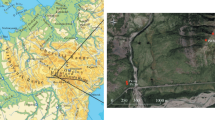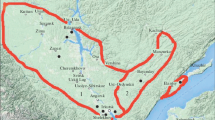Abstract
The complex studies of hydromorphism features in taiga weakly differentiated soils using morphological (color), chemical (iron content in different extracts, indicators of reducing conditions (IRIS)), and geobotanic (using the Ramenskii scale) methods have led to ambiguous conclusions. In all the soils, surface gleying was manifested. According to the results obtained by different methods, the maximum reduction processes were related to either the sublitter or the next deeper horizon. The Schwertmann coefficient, the criterion of Bodegom, and the Ramenskii scale indicated an increase of hydromorphism in the soils studied in the following sequence: the lower part of the ridge slopes drained by the small gullies < the middle part of the slopes < the flat tops of the ridges < the depression between the ridges. The morphological diagnostics of gleying proved to be a less sensitive method, which can recognize only the most contrasting hydromorphic soils. The lower horizons in some taiga soils have a bluish gray color probably not related to the recent soil hydromorphism.
Similar content being viewed by others
References
N. A. Avetov, S. A. Avetyan, E. I. Dorofeeva, and S. Ya. Trofimov, “Automorphic taiga soils of the Sredneobskaya Lowland,” Eur. Soil Sci. 45(7), 651–656 (2012).
A. F. Vadyunina and Z. A. Korchagina, Methods for Determining Soil Physical Properties (Vyssh. shkola, Moscow, 1961) [in Russian].
Yu. N. Vodyanitskii, Diagnostics of Waterlogged Mineral Soils (Pochv. inst. im. V.V. Dokuchaeva RASKhN, Moscow, 2008) [in Russian].
Yu. N. Vodyanitskii, Iron Compounds and Their Role in Soil Conservation (Pochv. inst. im. V.V. Dokuchaeva Rossel’khozakad., Moscow, 2010) [in Russian].
Yu. N. Vodyanitskii, A. A. Vasil’ev, and V. Yu. Gilev, “Iron minerals in soils on red-earth deposits in the Cis-Ural region,” Eur. Soil Sci. 40(4), 432–445 (2007).
Yu. N. Vodyanitskii, A. A. Vasil’ev, A. V. Kozheva, and E. F. Sataev, “Specific features of iron behavior in soddy-podzolic and alluvial gleyed soils of the middle Cis-Urals region,” Eur. Soil Sci. 39(4), 354–366 (2006).
L. A. Vorob’eva, Theory and Practice of the Chemical Analysis of Soils (Izd. GEOS, Moscow, 2006) [in Russian].
S. S. Voskresenskii, Geomorphology of Siberia (Izd. Mosk. Gos. Univ., Moscow, 1962) [in Russian].
I. M. Gadzhiev, V. M. Kurachev, V. N. Shoba, et al., Genesis, Evolution, and Geography of the Soils of Western Siberia (Nauka, Novosibirsk, 1988) [in Russian].
G. V. Dobrovol’skii, E. D. Nikitin, and T. V. Afanas’eva, Taiga Pedogenesis under Continental Conditions (Izd. Mosk. Gos. Univ., Moscow, 1981) [in Russian].
L. S. Dolgova and I. P. Gavrilova, “Specific features of soils in the middle and northern taiga subzones of Western Siberia (within Tyumen oblast,”in The Environmental Conditions of Western Siberia, (Izd. Mosk. Gos. Univ., Moscow, 1971), Vol. 1, 77–90 [in Russian].
F. R. Zaidel’man, “Morphogleygenesis, its visual and analytic diagnostics,” Eur. Soil Sci. 37(4), 333–341 (2004).
F. R. Zaidel’man, Gleyzation Process and Its Role in Soil Formation (Izd. Mosk. Gos. Univ., Moscow, 1998) [in Russian].
F. R. Zaidel’man and A. K. Ogleznev, “Determination of the degree of bogging from the properties of concretions,” Pochvovedenie, No. 10, 94–101 (1971).
N. A. Karavaeva, Swamping and Soil Evolution (Nauka, Moscow, 1982) [in Russian].
N. A. Karavaeva, Taiga Soils of Western Siberia, (Nauka, Moscow, 1973) [in Russian].
E. D. Lapshina, “Application of ecological scales for the assessment and prediction of the economic value of natural areas,” in Rational Use of Soil, Vegetative, and Animal Resources of Siberia, (Izd. Tomsk. Gos. Univ., Tomsk, 1986), pp. 86–91 [in Russian].
E. D. Lapshina and V. Bloiten, “Types of disturbances and natural restoration of vegetation of oligotrophic mires on oil fields of Tomsk obast,” Krylovia (Sibirsk. Botan. Zh.) 1(1), 129–140 (1999).
R. G. Mazitov, Extended Abstract of Candidate’s Dissertation in Biology (Novosibirsk, 2010).
N. F. Opryshko, Extended Abstract of Candidate’s Dissertation in Biology (Barnaul, 2000).
Soil Map of the Russian Federation. 1: 2.5 M Scale (GUGK, Moscow, 1988) [in Russian].
V. I. Savich, I. S. Kaurichev, L. L. Shishov, Kh. A. Amerguzhin, and O. D. Sidorenko, Redox Processes in Soils, Their Agronomic Evaluation and Regulation (Kostonai, 1999) [in Russian].
I. A. Tsatsenkin, I. V. Savchenko, and S. I. Dmitrieva, Methodological Guidelines on the Ecological Assessment of Rangelands in the Tundra and Forest Zones of Siberia and the Far East from Data on Their Vegetation Cover (All-Union Res. Inst. of Fodder Crops, Moscow, 1978) [in Russian].
E. A. Shishkonakova, L. I. Abramova, and N. A. Avetov, Experience in using ecological scales of L.G. Ramenskii for indication of disturbed landscapes in oil-mining areas of Western Siberia,” Probl. Region. Ekolog., No. 1, 50–55 (2006).
L. L. Shishov, V. D. Tonkonogov, I. I. Lebedeva, and M. I. Gerasimova, Classification and Diagnostic System of Russian Soils (Oikumena, Smolensk, 2004) [in Russian].
N. A. Awetow, E. A. Schischkonakowa, and K. H. Hartge, “Pflanzen als ökologische frühanzeiger anthropogener einflüsse auf die böden im erdölgewinnungsgebiet Westsibiriens,” Archiv für Forstwesen und Landschaftsökologie 41, 36–41 (2007).
K. Bryant, “Indicator of reduction in soils (IRIS) for wetland identification in Queensland,” Proc. 19th WCSS, Brisbane, Australia, Aug. 1–6, 2010 (Publ. on DVD, pp. 25–28).
M. Diekmann, “Species indicator values as an important tool in applied ecology - a review,” Basic Appl. Ecol. 4, 493–506 (2003).
H. Ellenberg, H. E. Weber, R. Dull, et al., “Zeigerwerte von pflanzen in Mitteleuropa,” Scripta Geobot. 18, 1–248 (1992).
V. H. Klauss, T. Kleinbecker, S. Boch, et al., “NIRS meets ellenberg’s indicator values: prediction of moisture and nitrogen values of agricultural grassland vegetation by means of near-infrared spectral characteristics,” Ecol. Indicators 14, 82–86 (2012).
P. V. Krasilnikov, “Mosaics of the soil cover and species diversity of aboveground vegetation in forest ecosystems of eastern Fennoscandia,” Eur. Soil Sci. 34(Suppl. 1), 90–99 (2001).
J. Kreck, J. Novakova, and Z. Horicka, “Ellenberg’s indicator in water resources control: the Jizera Mountains, Czech Republic,” Ecol. Engineer. 36, 1112–1117 (2010).
A. P. Shaffers and K. V. Sykora, “Reliability of ellenberg indicator values for moisture, nitrogen and soil reaction: a comparison with field measurements,” J. Veget. Sci. 11, 225–244 (2000).
U. Schwertmann and W. R. Fischer, “Natural “amorphous” ferric hydroxide,” Geoderma 10, 237–247 (1973).
A. L. Walker, “The effects of magnetite on oxalate- and dithionite-extractable iron,” Soil Sci. Soc. Am. J. 47, 1022–1026 (1983).
G. G. Wang, “Use of understory vegetation in classifying soil moisture and nutrient regimes,” Forest Ecol. Managem. 129, 93–100 (2000).
Author information
Authors and Affiliations
Corresponding author
Additional information
Original Russian Text © N.A. Avetov, E.O. Sopova, Yu.A. Golovleva, A.V. Kiryushin, P.V. Krasilnikov, 2014, published in Pochvovedenie, 2014, No. 11, pp. 1283–1292.
Rights and permissions
About this article
Cite this article
Avetov, N.A., Sopova, E.O., Golovleva, Y.A. et al. Diagnostics of hydromorphism in soils of autonomous positions on the Severo-Sos’vinsk Upland (Western Siberia). Eurasian Soil Sc. 47, 1077–1085 (2014). https://doi.org/10.1134/S1064229314110027
Received:
Published:
Issue Date:
DOI: https://doi.org/10.1134/S1064229314110027




